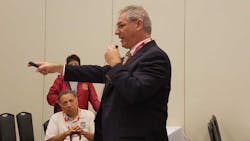One of the biggest challenges a firefighter faces upon being promoted to an officer position is handling personnel on levels that go beyond tactical behavior and enter the realm of conduct and personalities.
Last week at Firehouse Expo in Nashville, former fire chief David A. Hall offered a unique presentation entitled "Taking Command of Personnel Issues," which was one of the more engaging and interactive educational sessions at the conference. Hall is a 33-year veteran of the fire service who serves as University Emergency Manager at Missouri State University in Springfield, a city where he held the position of fire chief from 2009-2017.
"The best part and the worst part of our job has to do with people," Hall said to the attendees, who represented a balanced cross-section of the fire service with chiefs, assistant chiefs, battalion chiefs and rank-and-file firefighters among them. "We love who we work with, but it's also very difficult to manage people."
A Fireground Approach
Hall's primary message is that handling personnel can function in the same way a crew does when it arrives to a fire scene:
- Initial Size-up
- Determination on Resources
- Strategy & Tactics
A company officer or chief can implement these three concepts when looking at the personnel of his or her department. You can size-up the abilities and personality traits of the firefighters under your command, determine any additional resources or tools that can help them excel on a personal level, and maintain a strategy for dealing with each person if and when the need arises.
The same three steps apply to any issues that may come up, and some of the examples given included drinking on the job, sexual harassment, a firefighter taking a personal call while dealing with a patient, an engineer driving erratically or unsafely, and firefighters viewing explicit material in the firehouse, among others.
The keys to understanding personnel where discipline may be required is to first consider the nature of the issue. While the difference between a misdemeanor and a felony should be obvious to a fire officer, there are far more subtle instances that involve things such as liability, ethics or long-term consequences, be they internal for the department or political in nature.
The major elements to consider when sizing up an issue are:
- Was a law broken? (misdemeanor or felony)
- Was a rule broken? (city, county or department rules)
- Are there liability concerns? (city or county, department, personal)
- What are the ethics involved? (national, department or community standards)
- Will it have public relations implications? (news media, social media, public knowledge)
- Will there be political consequences? (internal strife, funding or staffing cuts)
- Will it affect group cohesiveness? (coworker interaction, long-term behavioral concerns)
- How many people were involved? (greater numbers often complicate matters)
- Were there previous incidents? (patterns of behavior, unsuccessful discipline)
Some instances may have a level of overlap with these elements, but Hall was quick to stress that this isn't always the case and that the difficulty is typically found in places where some may see a grey area while others do not.
"Not everything has to be technically illegal for there to be civil liability," Hall said. "Think about sexual harassment as an example of that. You're not going to be arrested for it, but you might have department liability and you might have personal liability."
Ethics can also be a complicated concept to unpack for a fire officer because ethics can vary from region to region or from department to department. Something that may seem like a minor incident in one area of the country may be looked at differently in another.
"I come from the Ozarks in Southwest Missouri," Hall said, "and our standards concerning ethics are going to maybe be a bit different that what they are in California or on the East Coast. It can really vary by the region that you're in."
Once an issue has been sized up by the officer, the potential outcomes or objectives need to be considered:
- Changing or improving behavior
- Keeping it contained to the people involved
- Limit the consequences to the organization
- Limiting the impact to you personally
This then leads the officer into how they should tactically approach the situation:
- Offensive (the officer believes it best that he or she handle the issue on their own)
- Transitional (an officer starts out handling it alone but may require additional support)
- Defensive (no direct action is taken and the issue is carried up the chain of command)
Real-Time Decisions
After Hall gave the session attendees a rundown of the fireground model to handle personnel issues, things got interesting when he used four white boards in each corner of the conference room to represent four tiers of discipline:
- Do Nothing/Coaching or Counseling
- Verbal or Written Reprimand
- Suspension/Demotion
- Last Chance Agreement/Termination
The firefighters in the room were shown a series of video dramatizations that offered scenarios involving personnel, and after each one ended were then asked to stand in the corner of the room that contained the disciplinary decision they would make.
The attendees started out slowly moving around the room as if they were second-guessing their instincts, but after the first few scenarios they began to get in the spirit of things and engaged in a spirited discussion and debate about their different approaches.
While one chief took a scenario in which a firefighter was reported for drinking on the job very seriously and chose a suspension, another chose to do nothing until all the facts were in. It was subtleties like these involving issues of hearsay vs. factual proof that showed how complex personnel issues can be and gave the session an energetic feel for those attending.
The complexities also manifested in regional ways. For example, one officer from California brought up his state's Firefighter Bill of Rights and how it can play into his decisions in a way that it wouldn't for another officer in attendance who was from Kansas.
"There often is no right answer on a lot of these issues, but understand that the decisions you do choose to make will have an impact on you, your crew and your organization," Hall said.

John Kosik
John was the managing editor of Firehouse after joining the Firehouse team in April 2017 after spending most of his career in journalism writing and editing sports and music content for the Associated Press in New York City. Transitioning into coverage of the fire service industry was a move close to his heart with several friends and family members serving in the FDNY. He lives in Chicago.






